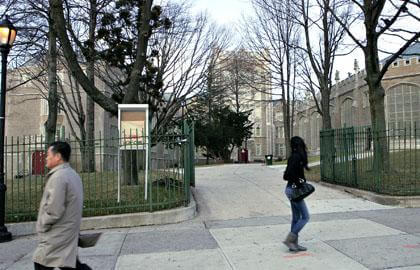By Connor Adams Sheets
The state Department of Education announced last Thursday that Flushing High School is one of the state’s 57 persistently lowest achieving schools, a designation that means an uncertain future for the self-described oldest public school in the city.
By making the list of lowest achieving schools, Flushing High has become eligible, under New York’s new school reform agenda, for funding and interventions to turn it around.
The state will provide $500,000 in federal funds to any school on the list that implements an intervention by redesigning or replacing the school, converting it into a charter school, transforming it according to certain criteria, or closing the school.
City Schools Chancellor Joel Klein “has good choices which I believe will preserve the system and won’t create chaos. If you go to school closures, you’ll see chaos. He has good options in the transformation and turnaround models,” Flushing High School Principal Cornelia Gutwein told a meeting of the school’s parents association Tuesday evening. “I prefer any model that keeps the school intact, but I can’t give you my personal favorite.”
Flushing High was identified as one of the 57 schools because of its low graduation rate. The school’s four-year graduation rate for the 2008-09 school year was 54.6 percent and its enrollment was 2,616 students. The school had to have graduation rates above 60 percent for the 2006, 2007 and 2008 school years in order to avoid making the list, and they weretoo low each year.
State Assemblywoman Grace Meng (D-Flushing) said she sent a letter to Klein and is working with Gutwein to help the school avoid closure.
“The state listed 57 schools that were not doing well in New York state — unfortunately Flushing High School is one of them,” Meng said. “That is a good thing in that it makes it eligible for federal funding, but we want to make sure it doesn’t get shut down.”
The city and state have neither ruled out nor selected any of the intervention options. Danny Canner, spokesman for the city DOE, noted that in the past schools have not been closed outright without being replaced.
“We do a phase-out and replacement approach rather than a closure. To date that is the strategy we have pursued, but again once the state provides guidance we will engage in a planning process for each of these schools to maximize funding available in order to turn the schools around,” he said. “The state has not laid out guidance, so what exactly that process looks like we don’t know yet, but the city will be working with the school and the state.”
Jane Briggs, a spokeswoman for the state DOE, said the schools will now analyze their own needs and decide what works best for them, then submit their plans to the state for approval.
“Once they’ve chosen one of those four options, we’re looking for some creativity or innovation from them to determine what will work best for them, so that we’re not just telling them what to do,” Briggs said.
Bibi Hanif, a Flushing resident with a son in ninth-grade at Flushing High School, attended the Tuesday meeting. She said she believes the school should have been given more time to improve, but she is now considering pulling her son out and transferring him to Bayside High School, where another one of her children went.
“The school, the education level has been going down for the last six years and now this,” she said. “I’m looking to see if I can transfer him to Bayside because if you wait until June, it might be too late. The faster they make the decision the better it is for school.”
Reach reporter Connor Adams Sheets by e-mail at csheets@cnglocal.com or by phone at 718-229-0300, Ext. 138.
































